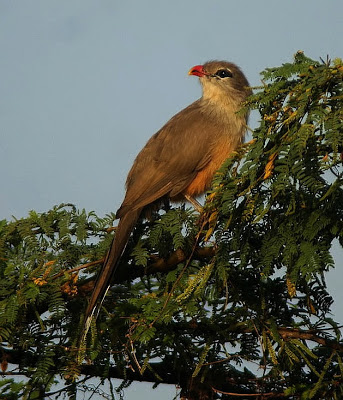The Koel called Kokil in Bengali, is the commonest and most familiar of Indian Cuckoos and is found in Tiruvannamalai District as well as the rest of India.
 |
| Handsome Male Koel |
Cuckoos are found all over the world, but are not numerous in species except in warm regions. They have slightly curved bills of moderate size, with conspicuous nostrils set low down and near the edge of the upper chap, and their toes are in two pairs, the outer front toe being turned backwards, as in Woodpeckers and Barbets. Tree-Cuckoos, which, in the East at all events, lay their eggs in the nests of other birds, have long wings and short legs, while Bush-Cuckoos, which always bring up their own young, have short wings and long legs suited for running; the Tree-Cuckoos on the rare occasions when they come to the ground, being only able to hop. Cuckoos usually have long rounded tails, and are very readily recognizable when a few have been seen.
 |
| Close up of Male Koel |
Cuckoos have peculiar notes and are generally more heard than seen. They generally feed on insects, and are exceedingly useful birds. Only in India are any Cuckoos commonly kept as cage-birds, they are not hard to rear, but require hand-feeding for a longer time than other birds.
The Koel is about as big as a large pigeon, with a long rounded tail; its whole length being nearly a foot and a half, it measures 39–46 cm (15–18 in) and weighs 190–327 g (6.7–11.5 oz). It has a peculiar steady level flight which makes it easily recognizable.
 |
| Male Koel |
The cock and hen differ absolutely in colour, the former being a glossy blue-black, while the latter is brown, spotted with white on the head and back, and barred with that colour on the wings, tail and under parts; altogether she rather reminds one of a hen pheasant in colour. Both male and female have pale green bills, bright red eyes and lead-coloured feet.
Young birds have black bills and grey eyes; in plumage they resemble adults of the corresponding sex, but not completely, young cocks being usually slightly marked with buff, and young hens having the head and top of the neck black. But there appears to be some variation, so that young cocks may be found in female plumage and vice versa.
Video of the song of the Koel
The Asian Koel is omnivorous, consuming a variety of insects, caterpillars, eggs and small vertebrates. However the adult bird feeds mainly on fruit. They will sometimes defend fruiting trees that they forage in and chase away other frugivores. They have been noted to be especially important in the dispersal of the sandalwood tree in India. Large seeded fruits are sometimes quickly regurgitated near the parent tree while small seeded fruits are ingested and are likely to be deposited at greater distances from the parent tree. They have a large gape and are capable of swallowing large fruits including the hard fruit of palms.
 |
| Female Koel with distinctive colouring |
This bird is much beloved by indigenous locals who admire the bird’s fine mellow call and it is with them quite a bird of romance with its glossy black plumage. The Koel deserves consideration from all, not only on account of its beauty and musical capacities, but for being one of the very few creatures which scores off the Crows, those birds being the foster-parents which it selects for its young.
 |
| Beautiful photograph of male and female eating |
The Asian Koel is a brood parasite and lays its egg in the nests of a variety of birds, including both the Jungle Crow and the House Crow, but the House Crow is the usual victim and the egg of the Koel is a miniature of a Crow's egg, being about an inch long, and green with brown spots.
 | ||
| House Crow at its Nest |
Sometimes two Koels' eggs may be found in one Crow's nest, and at times the big black Jungle-Crow has to do parental duty for the Koel. The most curious thing about the whole business is that the Crows, although they bring up the young Koel and feed it even after it has left the nest, yet evidently know there is something wrong, for they cherish a lively prejudice against the old Koels and hunt any Koel they can to death if they get the chance
Koels breed from March to July, and at this time the call whence is derived its Hindustani name ''ko-eel ko-eel'' running up the scale, is one of the characteristic sounds of the country. Unfortunately the bird insists on calling at night as well as by day, and is rather apt at all times to be "instant out of season;'' whence thus many call the Koel, the Brain-fever Bird, and detest it accordingly.
[Narrative taken from book by Frank Finn]















.jpg)


.jpg)












-_Immature_at_nest_in_Kolkata_I_IMG_7877.jpg)











